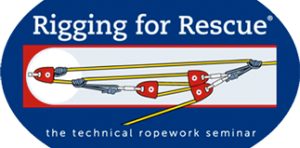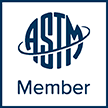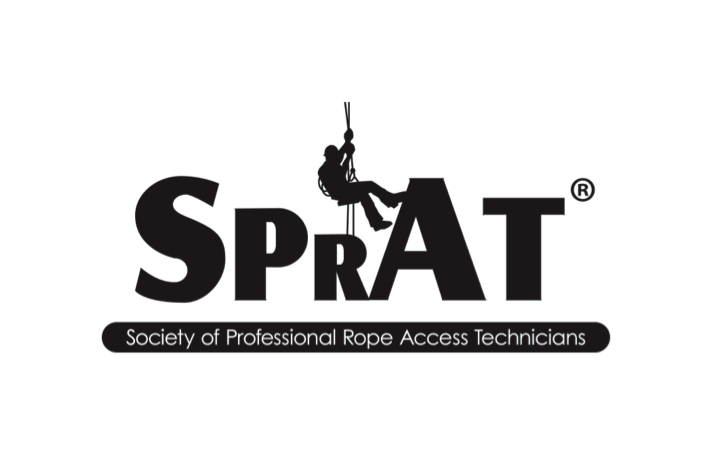RfR Specialty Techniques-Ouray, Colorado
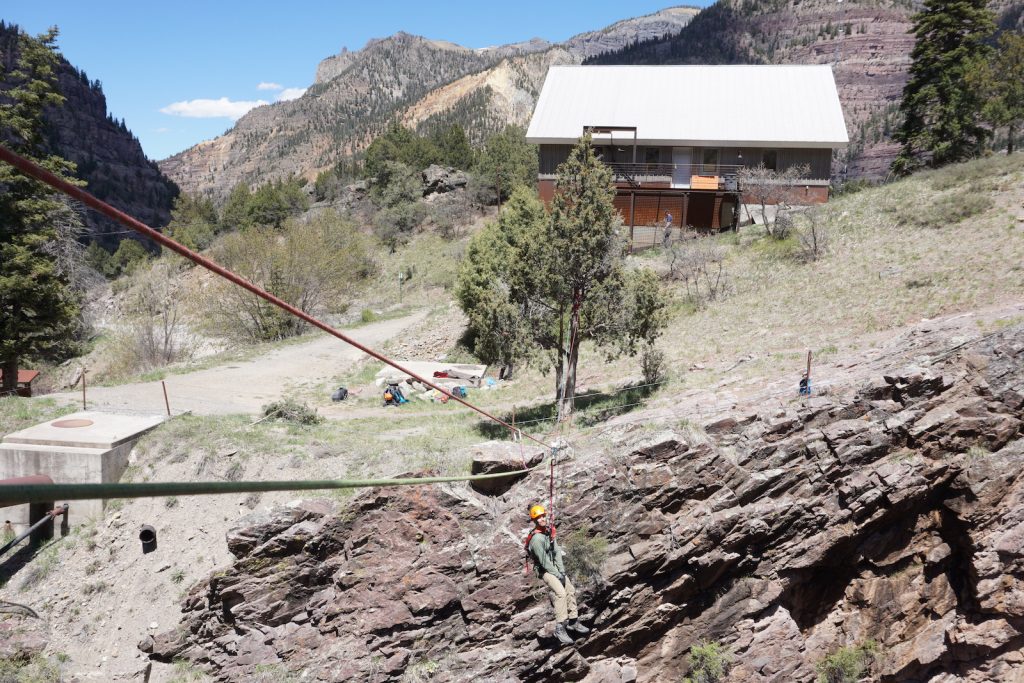
Last week we hosted our spring offering of the RfR open enrollment Specialty Techniques seminar. The participant mix was skewed towards the fire rescue side of rope rescue. As a result, we covered numerous topics & techniques that had applicability to fire rescue scenarios. Content included a compare/contrast of pickoff techniques, edge transitions simulating parapet wall challenges, and numerous discussions/exercises/critiques pertaining to both Two-tensioned Rope Systems with MPDs as well as Single Main and Separate Belay approaches. We wrapped up the week with a Kootenay Highline System – both as a drooping horizontal highline and the Norwegian Reeve hoisting variation. The building in the background (of the KHS image) is our classroom for the week – you can see the drop-testing tower on the back of the building. Most of the training site locations are walking distance from the classroom. I have traveled all over the world instructing rope rescue seminars and have yet to encounter a location more optimal for training than our home base of Ouray, Colorado. The surrounding terrain is vast, varied, and easily accessible. Our next Specialty Techniques offering will be September 18-22, 2017.
Pararescue seminars in Ouray
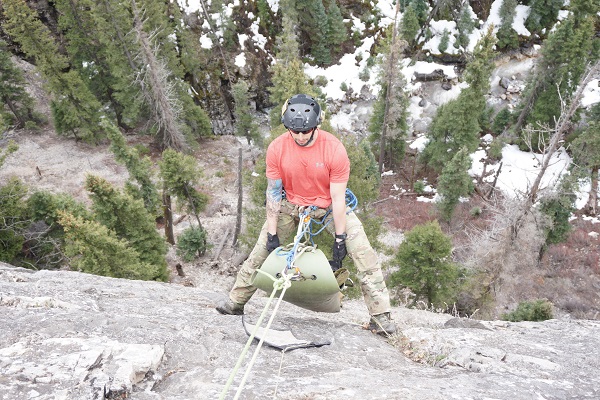
A couple of different USAF pararescue squadrons have paid us a visit in Ouray, Colorado this spring. The PJs are specially trained operators within the US Air Force, with skill sets that include rope rescue, climbing, scuba, parachuting, medical, and recovery – just to name a few. Because of the nature of their typical mission profile, the PJs tend to operate more like a remote mountain rescue team – similar to the rangers in Denali or Rainier National Parks. Weight is paramount to their speed of ingress/egress when operating in mountainous terrain. Less is more when it comes to gear and system requirements. Our recent rope rescue training’s included a lot of work with the SKED litter platform, lighter weight rope rescue systems/devices, as well as movement skills in 5th class terrain including multi-pitch rock climbing and rappelling. Where else but SW Colorado in the spring can you be surrounded by snow/ice and be rock climbing on dry rock in a t-shirt?
Denali National Park
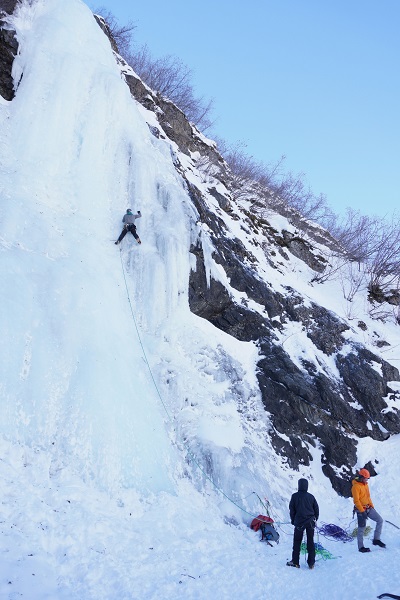
Weather in the desert southwest is decidedly warm and springlike this time of the year, but there is still an abundance of snow and ice up in the great white north of Alaska. Conditions this year were perfect for waterfall ice outside of Denali National Park. Our annual training with the climbing ranger cadre from Denali NPS included a focus on team-based movement skills on snow and ice. We completed a couple of different multi-pitch waterfall ice ascents to a rescue scenario, followed by applying safe & efficient descending techniques – both with and without a litter. The Denali NPS rangers are responsible for rescue throughout Denali National Park, but their primary focus end up being on the annual spring climbing traffic on Denali itself. The terrain on a peak like Denali can be quite complex ranging from crevasses to icefalls, big snow/ice faces, traversing features, rock walls, and of course the omnipresent cold and altitude. Some of the rope rescue problem-solving on Denali involves the use of specialized equipment such as the 1000m rope cached at high camp at 17,000 feet (that’s right, a full kilometer of rope – unknotted!). Denali is perhaps the ultimate in mountain rescue terrain insofar as the complexity and challenges that are presented to the respondents. It continues to be our privilege to work and train with these exceptional rescue practitioners and alpinists.
Moab Fundamentals
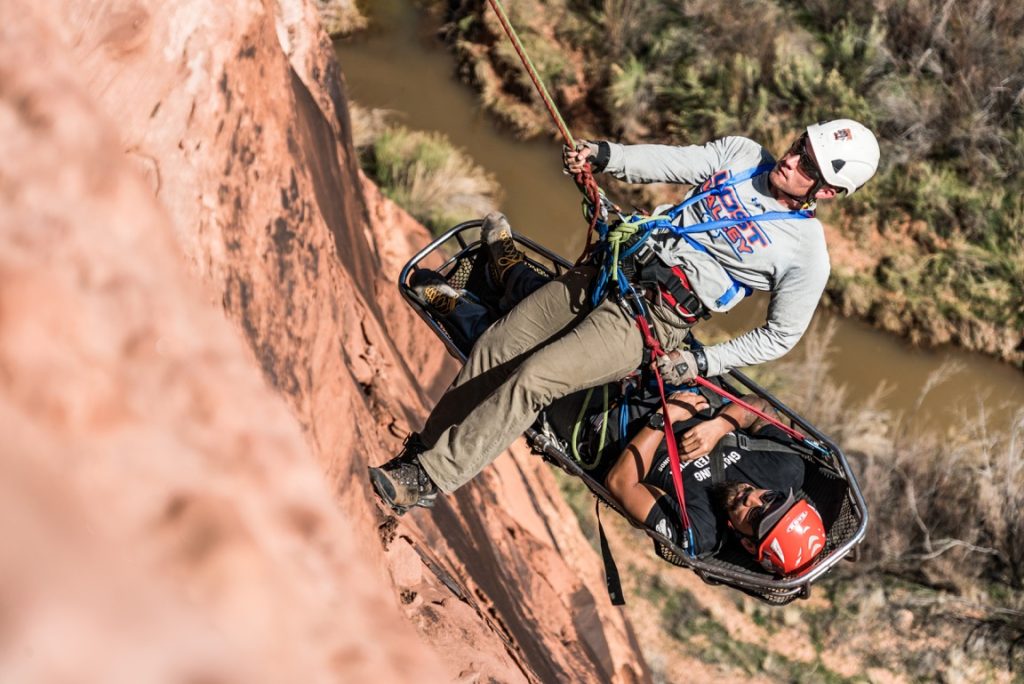
We recently completed a Fundamentals Seminar in Moab, Utah. The canyons surrounding Moab offer a truly magnificent location for developing and refining rope rescue skills. This program marked the beginning of Rigging for Rescue open enrollment Fundamental Seminars in Moab. In addition to perfect field training locations and amazing weather, participants and instructors alike are able to spend the evenings rock climbing, biking, or just enjoying all Moab has to offer. We look forward to offering additional training opportunities at this unique destination. The next scheduled Fundamentals Seminar in Moab, UT is on October 23-27 2017 http://riggingforrescue.com/program/fundamentals-7/. We hope to see you in the desert! Rigging for Rescue instructor Kevin Koprek teaching in Moab Photo by Xander Bianchi xanderbianchi.com
Mirrored Systems – Reflections From the Edge

ITRS, 2015 Abstract: “Mirrored Systems – Reflections from the Edge” Author: Mike Gibbs, Rigging for Rescue Background What is the primary objective in a technical rope rescue operation? It is to transport the subject from a place of predicament to a position of security – ideally, in a controlled and safe manner. There are many available systems, devices, and risk management approaches to accomplishing this objective. Distilling the alternatives down to a chosen system incorporates many different factors. The unique combination of these factors is driven by the mission profile. Mirrored Systems is one of the more recent technical rescue approaches to be introduced to the rope rescue community. The purpose of this study was to examine a Mirrored System under certain operational conditions in order to better assess the overall system performance and qualities. Methods A Mirrored System incorporating the use of MPD devices on each of the two operational ropes was examined in drop tests utilizing a fire department training tower. The key parameters included: • human operators on the devices• 200 kg test mass (steel plates)• zero free fall (snug toprope)• an artificial high directional in order to eliminate edge contact/friction• a coordinated shared-tension lowering of the test mass for a few meters followed by the intentional failure of one of the two rope systems using a pre-rigged quick release mechanism (at the test mass connection point) The operators of the two MPDs were not informed as to which rope system would be ‘failed’. After each test, stopping distances were measured and the operator of the integral system was interviewed for any notable observations. A total of 51 tests were conducted over the course of two days. Results Based on individual test results as well as operator interviews, it was evident that the MPD on the integral system did not self-actuate following failure of the other line. In other words, the device operator had to first recognize the situation (i.e. their rope accelerating) and then make a conscious decision to disengage the MPD release handle. Conclusion There are numerous benefits to two-rope rescue systems that share the overall tension between both ropes and their respective devices. However, a shared-tension lowering system can incorporate other risks such as the loss of device self-actuation – this would be of particular concern at the initial edge transition, when the system is first being ‘proof tested’. The Mirrored System using MPDs has this quality. A lack of system self-actuation can lead to increased stopping distances as well as the possibility of a complete ground fall. Furthermore, any system will incorporate this risk if it relies on operator action and reaction time to initiate fall arrest. MIRRORED SYSTEMS-REFLECTIONS FROM THE EDGE For more information, check out our testing video series.
High-Modulus Aramid Fiber Friction Hitches in Technical Rope Rescue Systems
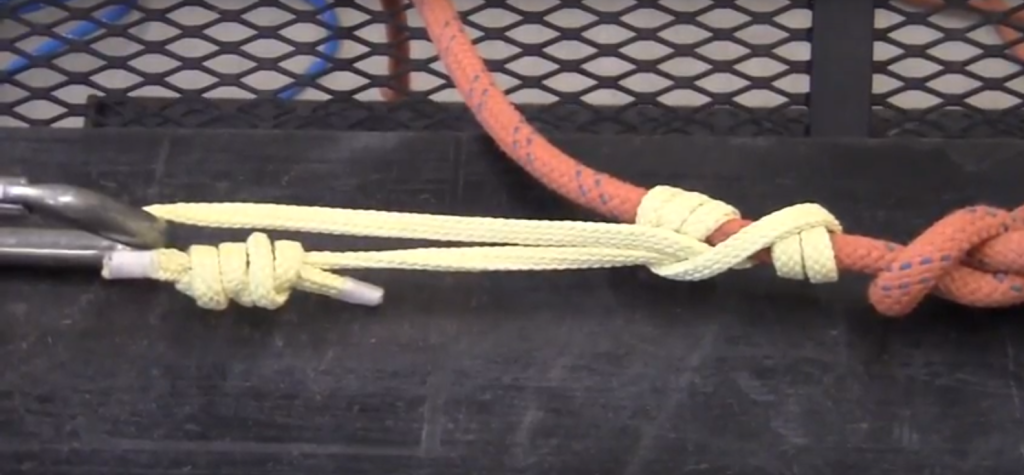
PROJECT VIDEOS Abstract In November, 2014, at the International Technical Rescue Symposium (ITRS) in Golden, Colorado, Mike Gibbs of Rigging for Rescue presented on the topic of aramid fiber friction hitches in rope rescue systems. This presentation was based on several different testing sessions over the course of a couple of years. The tests conducted included both slow pull examinations as well as drop testing. Included in this website posting is: • a selection of slides from the PPT given at ITRS• some of the test project video clips• the abstract submitted to ITRS The slides chosen are the primarily the ones that summarize the data from the tests conducted. The entire PPT is not included as it relies on the presenter narrative to properly convey our opinion of the research findings. PPT SLIDES
Multi-Point Anchor Equalization

Considerations for equalizing multi-point anchor systems International Technical Rescue Symposium (ITRS)[/fusion_text][fusion_text] Project Videos: https://youtu.be/oHtoomHZSRc Abstract Building sound anchors is one of the fundamental elements of recreational climbing, rope access, and technical rope rescue. Anchor configuration methods are also some of the most discussed, debated, varied, and perhaps doctrine-based skill sets in the entirety of ropework. However, much of the debate as to which anchoring technique is most appropriate for a given situation is dependent on anecdotal evidence as well as the way that we have always done it. The wide range of anchoring techniques and practices employed across different practitioners, organizations, and disciplines suggests that there is a high degree of unknowns and perhaps misunderstanding within the ropework community. In the spirit of increasing our own understanding of ‘how stuff works’ in anchoring, we chose to examine how dedicating more strands (i.e. material) to a given anchor point affects the overall load distribution in a multi-point anchor system. Additionally, we examined how a knot at a given location in a multi-point anchor system affects the force distributed to the various anchor legs. Our test method focused primarily on 2-point anchor systems with equal length legs. The leg lengths examined were either 1 meter per strand or 5.5 meters per strand in order to compare the effect of different amounts of material for a given test set-up. The research was conducted using a hydraulic ram slow pull machine and resultant forces were captured using electronic dynamometers at each of the two anchor points as well as at the focal point (aka master point of attachment). Over 150 slow pull examinations were conducted on a wide variety of configurations including: 1 strand vs. 2 strands, 1 strand vs. 3 strands, 2 strands vs. 3 strands, etc. Material used included 8mm low stretch kernmantle cord as well as 11mm low stretch rope. We discovered that there is a wide range of force distribution in even the most carefully constructed multi-point load distributing anchor system. Additionally, anchor systems that include a disparate number of strands dedicated to a given anchor point affect the force distribution significantly. And lastly, knots in the anchor system on individual strands affect the distribution further still. As ropework practitioners, when we approach a multi-point anchoring scenario with the intent of equalizing that anchor system, the techniques that we employ will likely have a significant affect on the overall force distribution achieved. Our given practices may be unintentionally favoring individual anchor points more than we intended. The reason that anchor system failures are a relatively rare occurrence likely speaks to just how overbuilt our systems are as a general practice. A more thoughtful approach to the rigging techniques employed in a multi-point anchor system will provide the greatest dividends when the overall quality of anchor points is dubious at best. Ideally this research can provide an impetus for further research in the topic as well as a critical thinking approach to ropework techniques and practices.
Parallel Plaquettes

A lightweight rope rescue system using common climbing equipment International Technical Rescue Symposium (ITRS) Project Videos: View the Complete Report Abstract A current review of rope rescue systems reveals a wide variety of techniques, equipment and risk management philosophies relative to moving live loads over complex terrain. Some teams use a single main line and a separate belay line; others employ the use of two mainlines to support the load without a separate belay. Descent control device choices run the gamut and include brakeracks, cammed devices, 8 plates and belay tubes just to name a few; rescue belay devices/systems are also numerous and include Tandem Prusiks, the Traverse 540° Rescue Belay, the Petzl I’D as well as several other devices. While some teams may elect to employ the use of single rope technique in certain circumstances, others would rarely move a live load without the use of a backup belay system. The reasons for the diversity in all of these subject matters include terrain, regional influences, culture, typical number of respondents, skill and training levels, cost, weight, commonality of equipment, perceived levels of risk, type and size of agency and many other considerations. The nature of the task is improvisational. Because of that quality, the solutions will always require judgment and that alone will ensure a certain level of diversity amongst ‘common industry practices’. One ‘big picture’ theme that seems to be pretty well agreed upon amongst practitioners is: 1. having system-wide auto-stop in place (i.e. the system does not require a human operator to hold or grip something in order to maintain security) The Parallel Plaquettes system is currently being examined as a potential option to meet that key rope rescue principle. The system was not designed for all rope rescue groups for reasons discussed above. For example, it is not compatible with 12.5mm rope. However, for those operating in a mountain rescue environment using smaller diameter rope it has the benefit of being constructed with ubiquitous gear that is likely already hanging from your harness.
Rescue Belays

Important Considerations for Long Lowers International Technical Rescue Symposium (ITRS) Project Videos: View the Complete Report Abstract Incorporating a belay system within a rope rescue system is common practice in rope rescue because, although the probability of a mainline failure is low, the consequence may be dire. Mainline system failures have occurred and will continue to occur, but what happens as a result of those failures will largely be driven by (1) the inclusion or exclusion of a belay system, (2) the specific nature of that system and (3) how that system is managed throughout the operation. The outcome depends on, among other parameters, the length of rope in service. Many studies have looked at belaying with a few metres of rope in service, but little data exists for larger amounts of rope. This paper will describe initial examinations of the problem of belaying on long lowers.
Lanyards Part II

An Examination of Purcell Prusik as Personal Restraint Lanyards Project Videos: View the Complete Report Abstract: In two independent drop test series conducted in 2002 and 2005, we examined the effects of a shock load on to various commercially made and user-configured personal restraint lanyards. Our primary focus in those two drop test series was to test daisy chains and other similar lanyards. We presented our findings at the 2005 ITRS held in Ft. Collins, Colorado. Several of the lanyards examined in 2002 and 2005 demonstrated serious shortcomings in a shock loading scenario due to either (1) excessive maximum arrest force (MAF) and/or (2) the lanyard failed or its condition was severely compromised. One of the lanyard configurations tested in 2002 and 2005 that showed some promise was the Purcell Prusik. Our intent in the 2006 drop test series was to conduct a number of drop tests on Purcell Prusiks in order to gain a better understanding of their capabilities and limitations as a personal restraint lanyard in a shock loading scenario. Our hope was to identify a suitable alternative choice to traditional lightweight personal restraint lanyards such as the daisy chain, for example.
